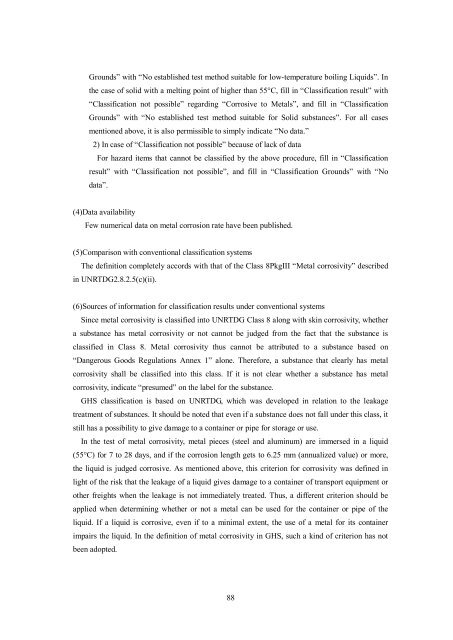GHS Classification Guidance for the Japanese Government
GHS Classification Guidance for the Japanese Government
GHS Classification Guidance for the Japanese Government
Create successful ePaper yourself
Turn your PDF publications into a flip-book with our unique Google optimized e-Paper software.
Grounds” with “No established test method suitable <strong>for</strong> low-temperature boiling Liquids”. In<br />
<strong>the</strong> case of solid with a melting point of higher than 55°C, fill in “<strong>Classification</strong> result” with<br />
“<strong>Classification</strong> not possible” regarding “Corrosive to Metals”, and fill in “<strong>Classification</strong><br />
Grounds” with “No established test method suitable <strong>for</strong> Solid substances”. For all cases<br />
mentioned above, it is also permissible to simply indicate “No data.”<br />
2) In case of “<strong>Classification</strong> not possible” because of lack of data<br />
For hazard items that cannot be classified by <strong>the</strong> above procedure, fill in “<strong>Classification</strong><br />
result” with “<strong>Classification</strong> not possible”, and fill in “<strong>Classification</strong> Grounds” with “No<br />
data”.<br />
(4)Data availability<br />
Few numerical data on metal corrosion rate have been published.<br />
(5)Comparison with conventional classification systems<br />
The definition completely accords with that of <strong>the</strong> Class 8PkgIII “Metal corrosivity” described<br />
in UNRTDG2.8.2.5(c)(ii).<br />
(6)Sources of in<strong>for</strong>mation <strong>for</strong> classification results under conventional systems<br />
Since metal corrosivity is classified into UNRTDG Class 8 along with skin corrosivity, whe<strong>the</strong>r<br />
a substance has metal corrosivity or not cannot be judged from <strong>the</strong> fact that <strong>the</strong> substance is<br />
classified in Class 8. Metal corrosivity thus cannot be attributed to a substance based on<br />
“Dangerous Goods Regulations Annex 1” alone. There<strong>for</strong>e, a substance that clearly has metal<br />
corrosivity shall be classified into this class. If it is not clear whe<strong>the</strong>r a substance has metal<br />
corrosivity, indicate “presumed” on <strong>the</strong> label <strong>for</strong> <strong>the</strong> substance.<br />
<strong>GHS</strong> classification is based on UNRTDG, which was developed in relation to <strong>the</strong> leakage<br />
treatment of substances. It should be noted that even if a substance does not fall under this class, it<br />
still has a possibility to give damage to a container or pipe <strong>for</strong> storage or use.<br />
In <strong>the</strong> test of metal corrosivity, metal pieces (steel and aluminum) are immersed in a liquid<br />
(55°C) <strong>for</strong> 7 to 28 days, and if <strong>the</strong> corrosion length gets to 6.25 mm (annualized value) or more,<br />
<strong>the</strong> liquid is judged corrosive. As mentioned above, this criterion <strong>for</strong> corrosivity was defined in<br />
light of <strong>the</strong> risk that <strong>the</strong> leakage of a liquid gives damage to a container of transport equipment or<br />
o<strong>the</strong>r freights when <strong>the</strong> leakage is not immediately treated. Thus, a different criterion should be<br />
applied when determining whe<strong>the</strong>r or not a metal can be used <strong>for</strong> <strong>the</strong> container or pipe of <strong>the</strong><br />
liquid. If a liquid is corrosive, even if to a minimal extent, <strong>the</strong> use of a metal <strong>for</strong> its container<br />
impairs <strong>the</strong> liquid. In <strong>the</strong> definition of metal corrosivity in <strong>GHS</strong>, such a kind of criterion has not<br />
been adopted.<br />
88
















